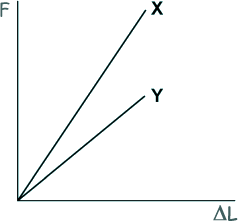Materials Q1. A sample of wire has a Young modulus E. When a force F is applied to it it extends by 10 mm A second sample of wire made from an identical material has three times the length and half the diameter of the first sample. What is the extension of the second wire if a force F is applied ot it?
ΔL = FL/AE ΔL∝ L So, three times the length makes it 3ΔL Diameter is related to area: A = ¼πd2 So ΔL ∝ 1/d2 1/½2 = 4 Halving the diameter makes it 4ΔL Put together we get 12ΔL = 12 x 10mm = 120 mm Choice D Q2. A sample of wire has a Young modulus E. A second sample of wire made from an identical material has three times the length and half the diameter of the first sample. What is the Young modulus of the second sample of wire in terms of E?
Q3. What is the name given to a material that breaks without deformation when a force is applied to it?
Q4. What cannot be used as a unit for the Young modulus?
Usual unit is N m–2 (choice A) or Pa (choice B) But F = ma so N = kg m s–2 therefore unit can be kg m s–2 x m–2 = kg m–1 s–2 (choice D) Answer is therefore Choice C Q5. Two separate wires X and Y have the same original length and cross-sectional area.
The sketch graph above shows the extension ΔL produced in X and Y when the tensile force F applied to the wires is increased up to the point where they break. Which statement is incorrect?
Energy stored is area under the graph - so A is true E is from the gradient - so B is not true - E for X is greater than Y. C is true - straight line D is also true
|
Follow me...
|






